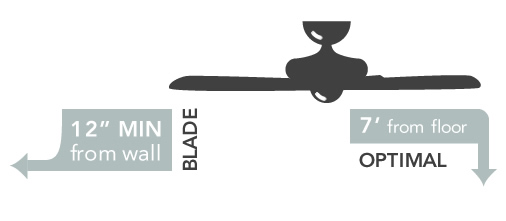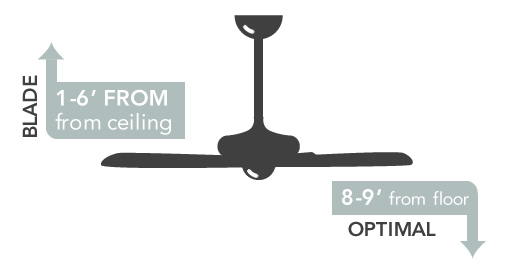5 Facts You Want to Know
Ceiling fans add a decorative element to a room or porch while adding comfort. Selecting the right style and finishes, in a proportion that fits the space and is sized to move the air comfortably, results in a fan that you’ll use everyday for years. It’s worth it. Here’s the how to.
1. To Circulate Air the Right Way? Find The Switch!
Use your ceiling fan year-round. Find the small switch located on the motor housing of your ceiling fan.
SUMMER Blades turn counterclockwise. If you use air-conditioning, a ceiling fan will allow you to raise the thermostat setting 4°F or more with no reduction in comfort. During moderately hot weather ceiling fans may allow you to avoid using your air conditioner altogether. Install a fan in each room that needs to be cooled during hot weather and you may be able to reduce your home’s summer energy use as much as 40%.
WINTER Blades turn clockwise. Your ceiling fan can help create a warming effect in winter and on cool autumn days. When operated in the REVERSE (clockwise) direction on a low speed, a ceiling fan creates a gentle upward draft, which circulates the hot air that often gets trapped at the ceiling.
2. Size it Right For the Space
| Suggested Fan Size | Application | Room Size |
| 29″ Blade Span | Bathrooms, hallways, closets, pantries | Up to 50 sq. ft. |
| 36″ Blade Span | Breakfast nooks, laundry rooms | Up to 75 sq. ft. |
| 42″ Blade Span | Small bedrooms, small kitchens | Up to 100 sq. ft. |
| 50″ or 52″ Blade Span | Standard bedrooms, family rooms | Up to 400 sq. ft. |
| 54″ or Larger Blade Span | Great rooms, large areas | Over to 400 sq. ft. |
3. Find the Spot… We Recommend:

Not all ceilings are eight feet high but you can still enjoy a ceiling fan. Look for fans that ride close to the ceiling in order to keep them seven feet from the floor.

Great rooms and soaring ceilings are perfect for ceiling fans. For these installations you’re fan should be hung by a down rod to eight or nine feet from the floor. Fan-to-floor height is important because he higher the fan is hung, the less air circulates near the floor. Choose an accessory down rod available in lengths of one foot to six feet to achieve your desired height.
Cathedral and sloped ceilings work well with ceiling fans. Select a fan with the right mounting kit for sloped ceilings up to 40°. Mount your fan as close as eight inches from the ceiling.
DIY? … Watch These First: Minka installation videos; Part 1 | Part 2
4. Performance
A ceiling fan is a motorized appliance. It should look good, but perhaps even more importantly run absolutely quietly, be perfectly balanced, and have enough motor capacity and blade pitch to actually move some air. So we need to get a little technical now and provide some tips to help you.
- Ceiling fan manufacturers are required by the EPA to label their cartons, brochures, catalogs and web sites with each model’s performance rating measured at its highest speed. The label will indicate the fan’s airflow in cubic feet per minute (CFM), electricity consumption in watts, and the airflow efficiency, which is a ratio of the first two, measured in CFM per watt. We can use these labels to effectively compare the performance of all ceiling fans.
- Now that you know how airflow and efficiency are measured, we recommend you put more emphasis on the airflow created rather than the fan’s efficiency. The most “efficient” fans available today will only save you around $10 to $20 per year when compared to the cost to operate the least efficient fans. Buying a fan that creates more airflow will allow you to raise your air conditioning thermostat a few more degrees, which, could create hundreds of dollars of annual savings.
- You’ve now learned how to compare fans, but what makes a fan good, or better, or best? These recommendations are based strictly on performance:
- Good – airflow in the 4000 to 5000 CFM range.
- Better – airflow in the 5000 to 6000 CFM range.
- Best – airflow over 6000 CFM.
- So, why buy a quality fan? Simple: longevity of the fan motor and components. Your fan should run quietly, improving the cooling or warming airflow of your room for years. You’re looking for that sweet spot: a fan you love, that moves the air, and is made of quality components so it will give you years of quiet service. As you shop our fans remember that fans considered purely decorative, like palm leaf or wicker bladed fans, are exempt from the labeling requirements entirely. These fans simply aren’t capable of moving much air but may be important to your decorative look.
5. Energy Savings
SUMMER During warm summer month’s fans do not lower the actual temperature in a room! They actually create a wind chill effect that lowers the perceived temperature. This might allow you to raise the setting for your air conditioner from say 72 degrees to 76 or 78 and still remain comfortable while saving considerably on your energy bill.
WINTER During the winter, run the fan at low speed in the opposite direction (clockwise). It forces the warmer air trapped against the ceiling out to the perimeter walls and back down into the room. As a result the warmest air is re-circulated down into the room and the heating system will not work as hard to heat the space. Don’t forget to flip the switch!
